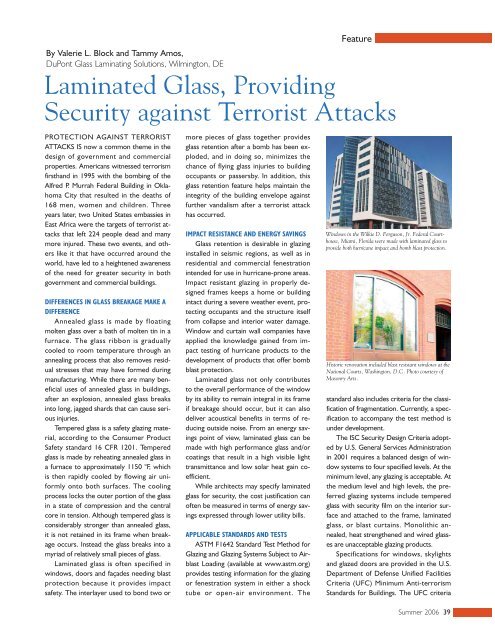(JBED) - Summer 2006 - The Whole Building Design Guide
(JBED) - Summer 2006 - The Whole Building Design Guide
(JBED) - Summer 2006 - The Whole Building Design Guide
You also want an ePaper? Increase the reach of your titles
YUMPU automatically turns print PDFs into web optimized ePapers that Google loves.
By Valerie L. Block and Tammy Amos,<br />
DuPont Glass Laminating Solutions, Wilmington, DE<br />
PROTECTION AGAINST TERRORIST<br />
ATTACKS IS now a common theme in the<br />
design of government and commercial<br />
properties. Americans witnessed terrorism<br />
firsthand in 1995 with the bombing of the<br />
Alfred P. Murrah Federal <strong>Building</strong> in Oklahoma<br />
City that resulted in the deaths of<br />
168 men, women and children. Three<br />
years later, two United States embassies in<br />
East Africa were the targets of terrorist attacks<br />
that left 224 people dead and many<br />
more injured. <strong>The</strong>se two events, and others<br />
like it that have occurred around the<br />
world, have led to a heightened awareness<br />
of the need for greater security in both<br />
government and commercial buildings.<br />
DIFFERENCES IN GLASS BREAKAGE MAKE A<br />
DIFFERENCE<br />
Annealed glass is made by floating<br />
molten glass over a bath of molten tin in a<br />
furnace. <strong>The</strong> glass ribbon is gradually<br />
cooled to room temperature through an<br />
annealing process that also removes residual<br />
stresses that may have formed during<br />
manufacturing. While there are many beneficial<br />
uses of annealed glass in buildings,<br />
after an explosion, annealed glass breaks<br />
into long, jagged shards that can cause serious<br />
injuries.<br />
Tempered glass is a safety glazing material,<br />
according to the Consumer Product<br />
Safety standard 16 CFR 1201. Tempered<br />
glass is made by reheating annealed glass in<br />
a furnace to approximately 1150 °F, which<br />
is then rapidly cooled by flowing air uniformly<br />
onto both surfaces. <strong>The</strong> cooling<br />
process locks the outer portion of the glass<br />
in a state of compression and the central<br />
core in tension. Although tempered glass is<br />
considerably stronger than annealed glass,<br />
it is not retained in its frame when breakage<br />
occurs. Instead the glass breaks into a<br />
myriad of relatively small pieces of glass.<br />
Laminated glass is often specified in<br />
windows, doors and façades needing blast<br />
protection because it provides impact<br />
safety. <strong>The</strong> interlayer used to bond two or<br />
more pieces of glass together provides<br />
glass retention after a bomb has been exploded,<br />
and in doing so, minimizes the<br />
chance of flying glass injuries to building<br />
occupants or passersby. In addition, this<br />
glass retention feature helps maintain the<br />
integrity of the building envelope against<br />
further vandalism after a terrorist attack<br />
has occurred.<br />
IMPACT RESISTANCE AND ENERGY SAVINGS<br />
Glass retention is desirable in glazing<br />
installed in seismic regions, as well as in<br />
residential and commercial fenestration<br />
intended for use in hurricane-prone areas.<br />
Impact resistant glazing in properly designed<br />
frames keeps a home or building<br />
intact during a severe weather event, protecting<br />
occupants and the structure itself<br />
from collapse and interior water damage.<br />
Window and curtain wall companies have<br />
applied the knowledge gained from impact<br />
testing of hurricane products to the<br />
development of products that offer bomb<br />
blast protection.<br />
Laminated glass not only contributes<br />
to the overall performance of the window<br />
by its ability to remain integral in its frame<br />
if breakage should occur, but it can also<br />
deliver acoustical benefits in terms of reducing<br />
outside noise. From an energy savings<br />
point of view, laminated glass can be<br />
made with high performance glass and/or<br />
coatings that result in a high visible light<br />
transmittance and low solar heat gain coefficient.<br />
While architects may specify laminated<br />
glass for security, the cost justification can<br />
often be measured in terms of energy savings<br />
expressed through lower utility bills.<br />
APPLICABLE STANDARDS AND TESTS<br />
ASTM F1642 Standard Test Method for<br />
Glazing and Glazing Systems Subject to Airblast<br />
Loading (available at www.astm.org)<br />
provides testing information for the glazing<br />
or fenestration system in either a shock<br />
tube or open-air environment. <strong>The</strong><br />
Feature<br />
Laminated Glass, Providing<br />
Security against Terrorist Attacks<br />
Windows in the Wilkie D. Ferguson, Jr. Federal Courthouse,<br />
Miami, Florida were made with laminated glass to<br />
provide both hurricane impact and bomb blast protection.<br />
Historic renovation included blast resistant windows at the<br />
National Courts, Washington, D.C. Photo courtesy of<br />
Masonry Arts.<br />
standard also includes criteria for the classification<br />
of fragmentation. Currently, a specification<br />
to accompany the test method is<br />
under development.<br />
<strong>The</strong> ISC Security <strong>Design</strong> Criteria adopted<br />
by U.S. General Services Administration<br />
in 2001 requires a balanced design of window<br />
systems to four specified levels. At the<br />
minimum level, any glazing is acceptable. At<br />
the medium level and high levels, the preferred<br />
glazing systems include tempered<br />
glass with security film on the interior surface<br />
and attached to the frame, laminated<br />
glass, or blast curtains. Monolithic annealed,<br />
heat strengthened and wired glasses<br />
are unacceptable glazing products.<br />
Specifications for windows, skylights<br />
and glazed doors are provided in the U.S.<br />
Department of Defense Unified Facilities<br />
Criteria (UFC) Minimum Anti-terrorism<br />
Standards for <strong>Building</strong>s. <strong>The</strong> UFC criteria<br />
<strong>Summer</strong> <strong>2006</strong> 39

















